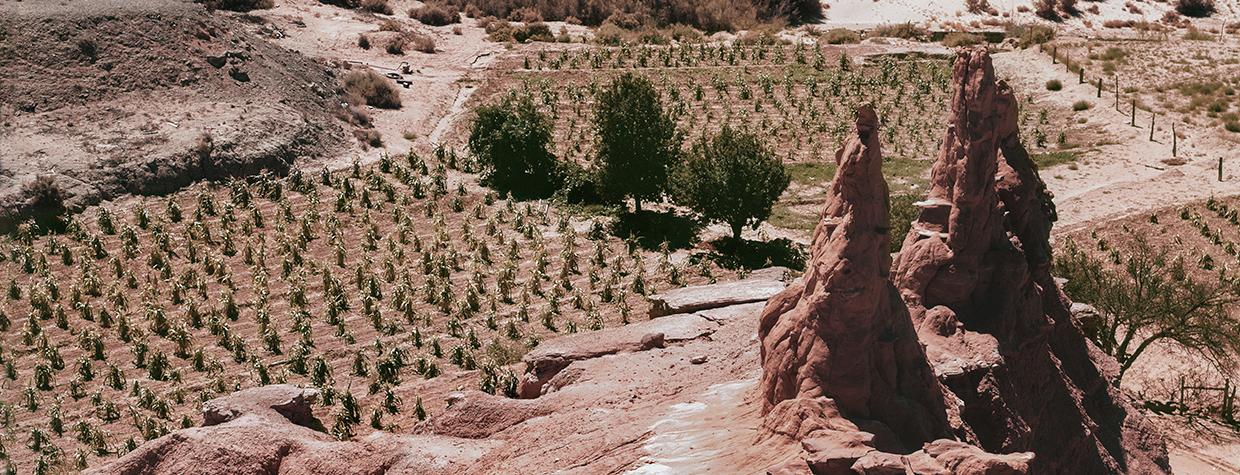Editor’s Note: As a general rule, photographers tend to focus on one of the various disciplines of the art form: landscape, portrait, macro, lifestyle. There aren’t many who excel in all of the above. And there are even fewer whose words measure up to their work behind the camera. Although Jerry Jacka was humble about his writing skills, and he’d be the first to tell you that his wife, Lois, could write circles around him — she can write circles around most people — his command of vowels and consonants was on par with his ability to capture a sunset over Walpi village. As you’ll see, Jerry could photograph anything, and he could write a nice story, too.
There is an uncanny balance between man and nature in the Hopi country. In summer it is hot and dry — very dry. Through the day, hot dry breezes sap the moisture from soil and vegetation. Later in the afternoon, giant thunderheads peer over the mesas, only to spread a few light showers upon the parched land; then they retreat to the north and east, hoarding their precious cargo of rain.
Dry as it may be, green patches of corn grow everywhere … on sandy hills and plains, on the banks of dry washes and even in the very bottoms of dry sandy creek beds. There are also fields of squash, beans and melons; but most of all, corn.
How do the Hopi people grow this corn? How long have they farmed this land? And why do they continue to farm under these most difficult conditions? For answers we must go to the Hopi villages, look into the heritage of the people and into the depth of their spiritual understanding and reverence for life.
Perhaps the single most important factor underlying the success of the Hopi farmer is his adaptability to the environment. The Hopi have learned to respect and live in close harmony with their land. To them, everything in nature is important and part of a well-balanced plan. The sky, with its stars and clouds; the Father Sun, the Mother Earth and all things which live upon it; even the sand and stone have significance.
Corn is a tradition and a way of life among the Hopi. These green stands of corn are a product of centuries of farming experience, handed down through the many generations.
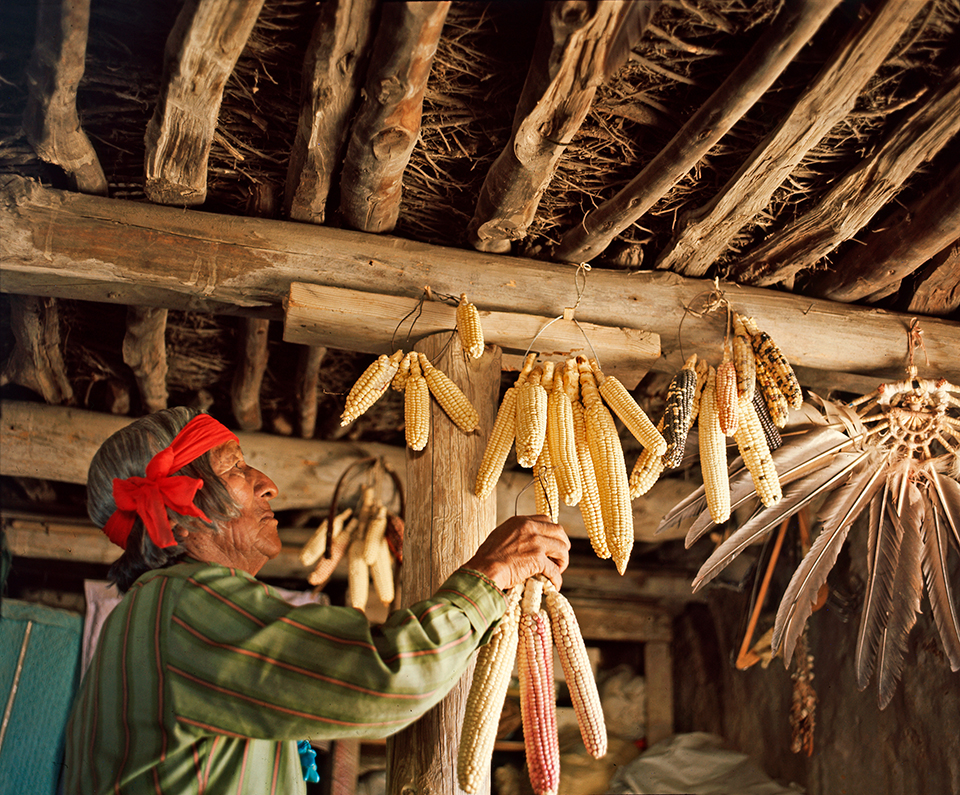
They are the result of careful planting practices and patient, continuous care of the fields, not unlike the loving care a Hopi mother gives her child. But this is not all. In order to be successful, the Hopi farmer would be the first to admit, he must also have the help of a power much greater than that of mortal man. This is acquired through religion, ceremonies and prayers.
Evidence of this deep abiding faith can be heard in the distant rhythmic sounds of a drum and the song of the kachinas, which, on a still day, might be heard coming from the mesas overlooking the fields. Too, there are pahos (prayer sticks), which are carefully placed in shrines, some in fields and others in various sacred locations throughout the land — the Hopi’s constant prayer for rain, good crops and all that is good ... for all people.
He (the little chipmunk) took his sacred corn meal in his right hand and stood over the plant and said his prayers in silence. Then, he threw the meal high up toward the sky. Then the others followed.
— from Truth of a Hopi, by Edmund NEQUATEWA
The origin of Hopi corn has its roots in prehistory. In the legendary underworld of Hopi genesis, corn was used prior to their emergence on the face of the Earth. Scientists, however, have yet to affix a date to man’s first use of corn in the Southwest, though archaeological evidence dates the use of a very primitive type of corn as far back as 2500 B.C. This “pod corn” was very small and each kernel was individually sheathed, unlike the modern-day variety, which has an individual husk over the ear.
On the fourth day all the tribes came together — Navajo, Supai, Paiute, Apache, Zuni, Utes and the Bahana (white man). When they came up, the chief had all the different kinds of seeds of corn and grain, of melon and fruit, laid out for them to choose. Then he asked the different tribes to step forward and take their choice.
The Navajo slipped forward hurriedly and picked out the largest ear of corn, which he thought was the wise thing to do. But the chief and the others knew that the long ear of corn could not last long and was not easily raised. Afterward the rest of the tribes took their choice in turn.
The Hopi took the shortest ear of corn and also squash and beans. The Apache didn’t take any, for they said they would rather live on game. Supai took some peaches — he preferred the fruit most. The Zuni took corn and wheat. Paiute didn’t take any — he, too, said he would rather live on wild game and fruit. Utes didn’t take any either. The Bahana took his choice last and was rather slow and considered well and finally he took some wheat which was not so heavy and he could carry more of it than the corn.
— from Truth of a Hopi
With time, new and more adaptable varieties of corn began to appear, and by the time of Christ, corn was probably beginning to be cultivated widely throughout the Southwest. It was during this period that cultures in the Southwest began to change. Agriculture, in particular the growing of corn, enabled a people who once were forced to devote most of their time to food-gathering to pursue new interests and rechannel energies to more diversified activities. These ancestors of the Hopi experienced the beginnings of new lifestyles and slowly, the era of the great pueblos blossomed. Undoubtedly, the importance of corn grew along with these new cultures.
There is my field. It is by an old ruin. This is where my clan people once lived. They grew corn here … as I do now.
— Hopi Farmer
The growing of Hopi corn today, although heavily influenced by the white man, bears remarkable similarities to the process used 1,000 years ago.
Most fields still are under control of the clans, having been passed down through generations of female lineage. Since the Hopi Society is matrilineal, field ownership is vested in the women. New farming plots may be utilized, but only with the sanction of clan leadership.
Hopi corn fields today range in size from one-half acre to ten or more acres. Site selection is usually based upon the capacity of the soil to retain water and the availability of water from surface runoff.
The choice of plots and growing techniques vary slightly between farmers of the three Hopi mesas, this being due, in part, to variance in general terrain. However, great differences occur at Moenkopi (meaning “place of the flowering stream”), a village on the far west end of the reservation where Hopi farmers are able to irrigate their crops, and at the villages of Hotevilla, Bacobi, and Sheep Spring, where terraced gardens are spring-fed.
Prior to planting, men, women and children clear the fields of weeds by hand. With few exceptions, Hopi farmers do not enjoy the luxury of mechanized farm equipment, or even a horse or mule. Those few who do own tractors often use them only for initial field preparation, carrying out the planting and subsequent tasks by hand.
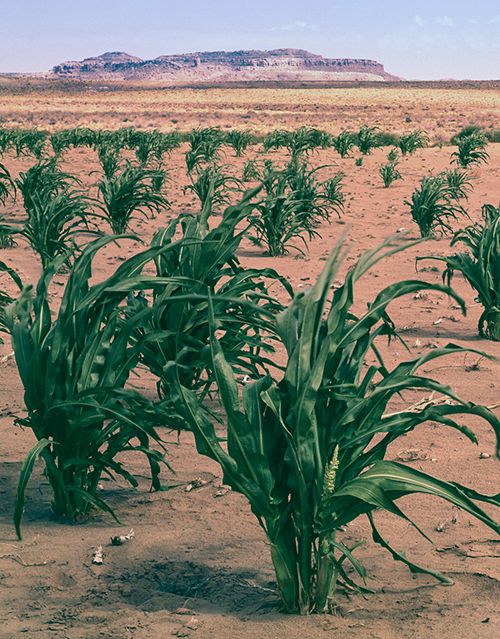
Planting time, itself, is determined by the position of the rising sun in relationship to fixed landmarks on the eastern horizon. In fact, this centuries-old method of determining “time” is used to begin ceremonies and other major events as well.
The person responsible for keeping track of the sun’s path is called the Sun Watcher or Sun Chief (Tawawunitaka). When the sun is right, the Sun Watcher informs the appropriate leader or “crier” who announces the beginning of the event.
At Second Mesa, the village chief (Kikmongwi) of Shongopovi is the Sun Watcher. From high on top of the village roofs, he sings a prayer song that announces the beginning of the planting season. The bear clan is the first to plant at Second Mesa. Members of the other clans, men and boys alike, join in a “planting party” to assist this “chief clan” with their initial planting. Then the other clans can begin their planting.
Each year there are two plantings of corn. The first or “early” planting is usually in mid-April. This crop produces some corn for general use and, perhaps of more importance, it furnishes corn and green corn stalks for the Niman kachina ceremony or Home Dance in July. This is the last of the major ceremonies of the Hopi kachina cycle. The dance, itself, acknowledges the sources of heat, moisture, germination and magnetic forces of the air. The main corn crop then is usually planted in late May or early June.
The traditional planting stick is still used extensively. It is usually made from the stalk of salt brush two to three feet in length and sharpened to a wedge-shaped point at one end. Evidence of the planting stick in the Southwest has been found, placing it as far back as 300 to 400 B.C. It is likely that it is as old as domesticated maize itself. In some cases, today, wood planting sticks are being replaced by short lengths of pipe or metal rod, flattened to a point at one end.
Considering the method used, the Hopi farmer plants his corn with remarkable speed. The crop is usually planted in rows, each about four paces apart. First a thin layer of soil is removed, either by hand or hoe, leaving a shallow indentation. Then, with the aid of the planting stick, a small hole is dug in the ground, usually to the depth of eight inches or more, until moist sand is found. When the hole is at the desired depth, the soil at the bottom is loosened with a few last strokes of the stick, and a handful of kernels, usually eight to twelve, is placed in the bottom of the hole. The moist soil removed from the hole then is replaced directly on the kernels and the hole is filled with the remaining soil.
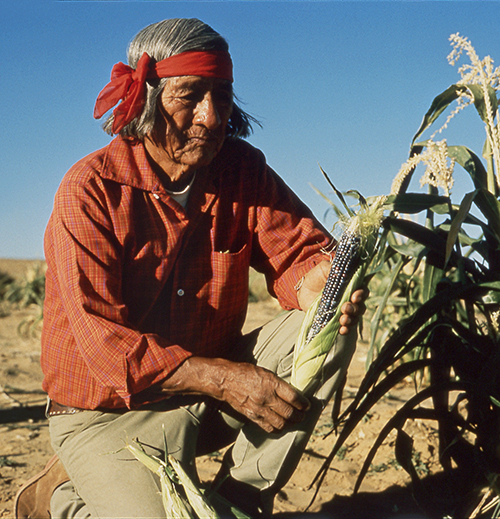
Two key factors in a successful planting are surrounding the seed with moist soil and sufficiently warm temperatures, both of which are necessary for germination.
Planting is done by the men and boys of the clan. Quite often, Hopi men will farm several fields alone or with the help of one or two boys. Occasionally, planting parties made up of groups of farmers, families and neighbors will assist one another in planting larger fields.
Occasionally a corn planting dance is performed by the kachinas. Following this, they proceed to the fields to plant corn. The planting usually concludes about noon when the kachinas return to the village to dance until sundown.
When planting is finished, a feast is given for all who took part in the day’s work. The supper table is plentifully stocked with a large variety of food, including fresh baked bread, piki, fry bread, mutton or beef stew, hominy, beans, pies, cakes, coffee — and more. Frequently, a bowl of water is placed with each table setting. Each person sprinkles a liberal amount of sweet corn meal in the water which then serves as a beverage.
At this point, the Hopi farmer’s work has actually just begun; for nature challenges his skill with a number of obstacles, any of which can easily destroy an entire crop: the moisture-robbing winds can be a constant threat to the small shoots as well as the mature ears of corn; worms, kangaroo rats and gophers often attack the plant roots from below; rabbits and prairie dogs may nibble away at the top, while armies of ants tackle the entire corn stalk — even the seemingly immortal weeds may appear once again. And then, there is the rain ... either not enough or a cloudburst which can wash away an entire field of young corn.
The Hopi farmer deals with these problems in two ways. He utilizes his skills and ingenuity as a farmer, taking advantage of his own past experiences, plus those of his forefathers. And, of equal importance, he relies upon his religion. The entire growing cycle, from planting to harvest, is paralleled with a series of ceremonies and prayers.
When the planting is over, you go pray for rain — every day. That’s why we perform all kinds of ceremonies. Even the social dances ... the ladies are praying for things that benefit our children, especially the rain. The rain is the main thing. Rain can help our life. When our crops are up, we feed our families and feed our people.
— Hopi Farmer
As it is throughout the world, and for countless ages of the past, the harvest is a time of thanksgiving … and more hard work. The Hopi harvest is quite often a family affair, where young and old alike help. Other times a farmer may gather his crop alone over a period of days or even weeks, as time allows. The ears of corn may be picked, sheath and all, to be dried or husked in the field before they are taken home. Or as happens occasionally, the entire corn stalk will be picked for use in ceremonies, such as when Niman kachinas carry green corn stalks into the village plaza as ritualized gifts for family and friends.
After the harvest, colorful Hopi corn may be seen drying on rooftops and tables or hanging from rafters throughout the villages — a truly beautiful sight, and no doubt a rewarding one to those who have worked so hard. Again, there is feasting.
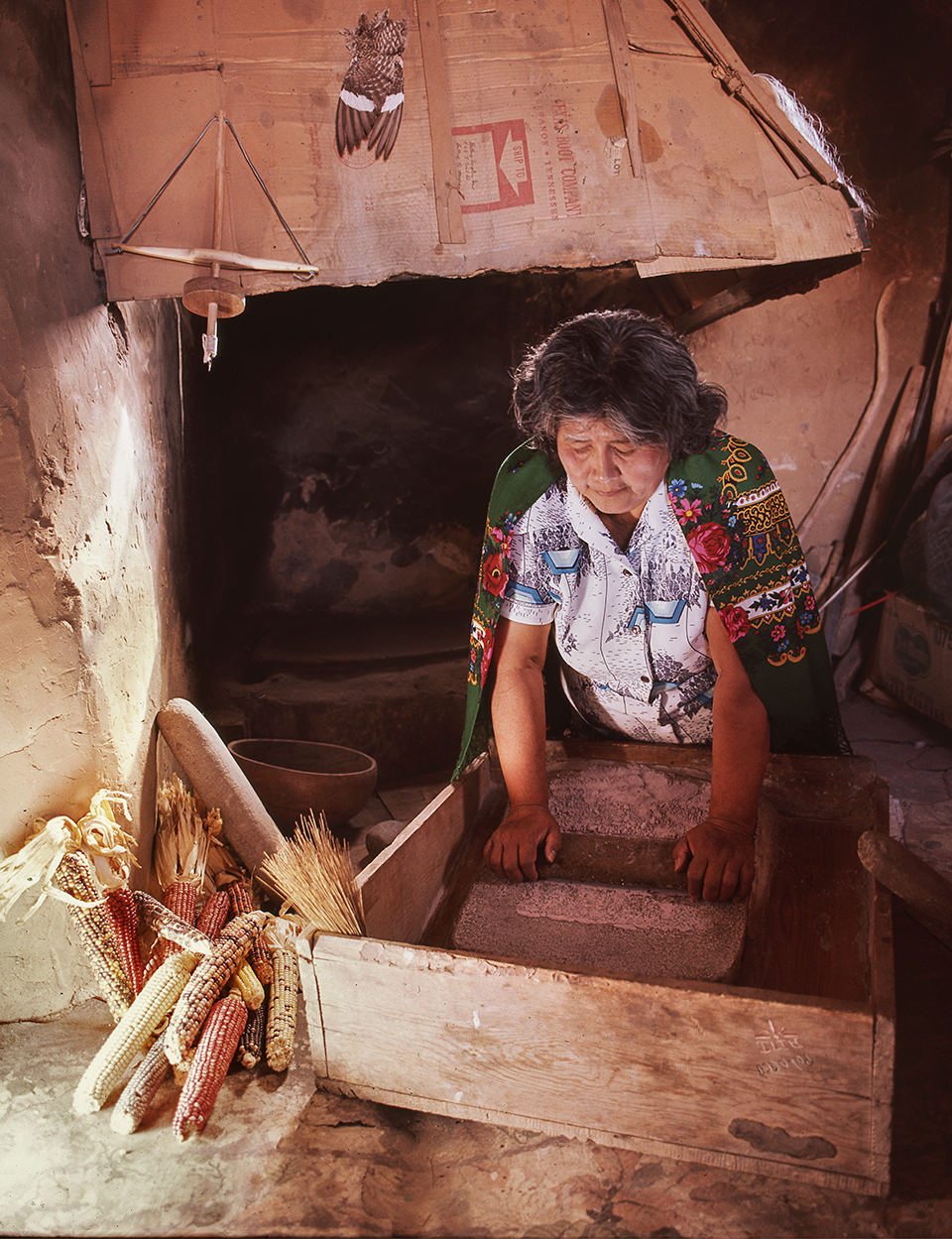
When the drying period is over the kernels are shucked by the women and the healthiest corn is set aside for future plantings. Other kernels are ground into meal for ceremonial use and for bread, cakes, mush and piki (a wafer-thin bread made of a batter of blue corn meal and ashes).
Early in the morning my mother used to grind the corn with her stones and make the corn meal out of it. And make the blue marbles, you know, Povolpiki … It’s good. But now we haven’t got much Hopi food. Now we eat like the bahana … eggs, potatoes, food from cans. My grandma, she used to have peaches, dried peaches to boil … and with the white corn meal she would make pikami ... but no coffee.
— Hopi Farmer
In ceremonies, the use of corn and corn symbols seem endless. Corn meal is a symbol of fertility and friendship, and also serves as ceremonial body makeup. Corn stalks are used during kachina ceremonies and corn husks in the making of pahos and parts of various ceremonial dress. An ear of corn will be placed with a newborn baby, symbolizing a spiritual relationship with the Earth, and one is given to each child at the time of initiation. Ears of corn also are carried by kachina dancers and are used extensively in a host of other ceremonies. Corn pollen, itself, is used symbolically in christenings, and young Hopi girls grind corn for four days as part of their initiation into womanhood. Symbols of corn appear on garments, headpieces and wands used during ceremonies and on altars.
While some of its meaning has been lost in time, additional knowledge concerning the ceremonial uses of corn is closely guarded within the confines of the pueblo kivas and by those entrusted with the perpetuation of religious life. Thus the complete story of Hopi corn — and its special value to other Indian tribes, as well — will probably never be revealed.
This old man at the rock under the fir trees would sprinkle
corn meal on the trees and they would grow about an inch
or two, and by the time the kachinas got there, they were quite tall trees …
— from Truth of a Hopi
Nurtured over the centuries into a nourishing and beautifully variegated maize, corn has had a strong influence on the people of this land. Perhaps no other single item has played so important a role in the development of a culture, a role that continues to be important even today.
Why does the Hopi farmer in this 20th century continue to plant his corn in sandy washes, on hills and plains with the aid of a planting stick? Why does he continue to struggle with the obstacles that make his task so great?
With the corn, we pray from it for rain. We pray from it for all life … all that is living … pray for the benefit of the people, all people, not just Hopi.
— Hopi Farmer
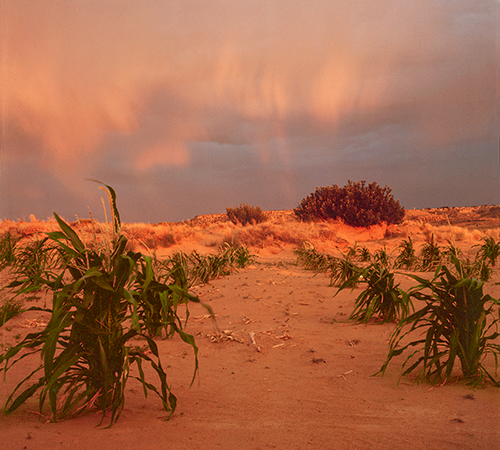
HOPI FARMING TODAY
Although Hopi people have been farming their land in much the same way for centuries, things can change. To get a sense of what may have shifted in the 40 years since this story first appeared, we asked Steven Lomadafkie to take a look. Mr. Lomadafkie is a teacher and the greenhouse manager at Moenkopi Day School, where, among other things, his students nurture cottonwood seedlings for restoration projects on Hopi tribal land. Here’s what he had to say after reading Jerry’s story:
“I was impressed with Mr. Jacka’s knowledge, and his understanding of how important heirloom Hopi corn is to the Hopi way of life. I also appreciated his sincerity. I believe stories like The Miracle of Hopi Corn can inspire future generations of Hopi farmers to carry on the traditional way of farming in this harsh environment. Of course, tractors are almost the norm in farming the land today, but there are some farmers who hold on dearly to and pass along the knowledge of traditional farming methods. For me, personally, this story has inspired me to continue the traditional way of farming. It’s worked for thousands of years, so why not today?”

